| |
|
|
|
Arlie Spencer, Jr
Sergeant
B CO, 5TH BN, 12TH INFANTRY, 199TH INFANTRY BDE, USARV Army of the United States Westland, Michigan February 19, 1949 to May 15, 1970 ARLIE SPENCER Jr is on the Wall at Panel W10, Line 47 See the full profile or name rubbing for Arlie Spencer |

  |
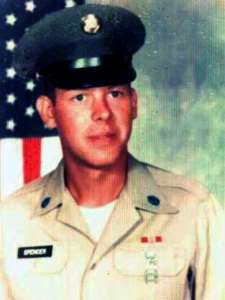
|


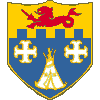
| |
|
This story began when the photo of Arlie Spencer was submitted by Michigan Vietnam Memorial Historian Jim Jennings for one of the Michigan men killed during the Vietnam War. Contact was subsequently made with Arlie Spencer's wife, Susan, for photo permission and to provide information to her and clarify conflicting information about the events surrounding Arlie's death and the deaths of the other men involved in events of May 15, 1970, in Cambodia. Susan replied: "Thank you for the updates. Unfortunately I think the photos of the grave marker you have may be the old marker. It was incorrect for 40 years and we finally had it changed a few years ago. If it says just "Arlie Spencer" and "Company C" it is the WRONG information. The correct marker is the Arlie Spencer Jr and Company B." 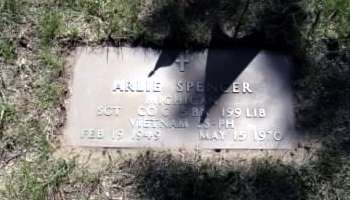
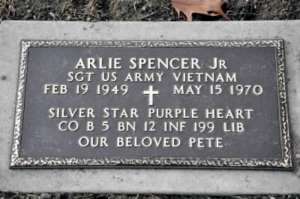
40 year old marker missing "Jr" and "Co C" as unit.
Marker with correct full name and "Co B" as unit.
"I do have other photos that you may be interested in. We have been blessed and we finally found the men who were with Pete when he was killed", she wrote. "They are a great group of guys...and actually there is a book written with their story and about Pete getting killed. "Raiding the Sanctuary" Thank you again....hope that helps. If not let me know. Kind Regards." - - - Susan In response to another query, Susan wrote:" "I have forwarded your information and questions on to Terry Braun....the other Platoon Sergeant and friend of Pete's. He knows and remembers a lot of information from then. Also Robbie Gouge is the gentleman who wrote books on the 199th. His father served with them and Robbie has attended events with the guys from the 199th." "Pete lived in Westland [Michigan] for a very short time before he was drafted but was actually from Kenucky. I am from Livonia MI and lived there most of my childhood. I left for the Army a year after Pete was killed to try to see what the war was about...but ended up at Fort Dix, New Jersey." "The guys from the 199th meet every year. Next year is in Washington DC. A great group of folks. They all have pictures, stories and memories that they share. I hope Terry and/or Robbie will be able to help you." "I am so happy to hear that this is all being placed out there for others to perhaps find and maybe we will find them." Kind Regards. - - - Susan Spencer, wife, June 2013. The 1st Cavalry Division's Operational Report for that period gives a broad outline of the swift moving events, to include the dates and events involving the 5th Battalion, 12th Infantry Regiment who were under the operational control of the 1st Cavalry Division's 2nd Brigade. The 5th Battalion, 12th Infantry had for nearly six months operated around Firebase Libby and Gladys in Long Khanh Province. Daily, they worked in extreme heat, heavy jungle, and monsoon rains, searching for the 274th Viet Cong Main Force Regiment and the 33rd NVA Regiment - with occasional success resulting in 2 to 3 enemy KIA: 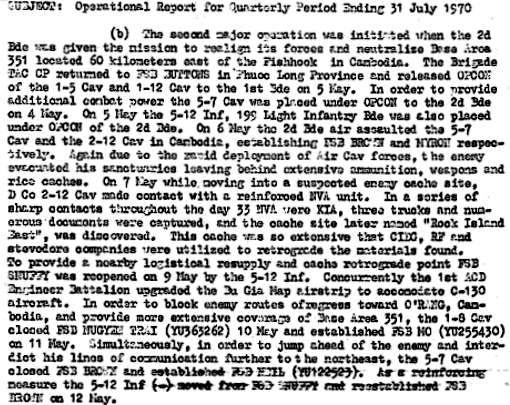
1st Cavalry Division Lessons Learned Report for Cambodia.
Cambodian events for the 5th Battalion of the 12th Infantry Regiment, 199th Light Infantry Brigade (LIB) (Separate) began during the morning of 5 May, 1970 when the 5-12th Infantry was released by the 199th to the operational control of the 2nd Brigade, 1st Cavalry Division, effective at 1840 hours. The battalion relocated to Phouc Long Province, near Song Be, in South Vietnam to operate and provide defense for FSB Buttons, the headquarters of the Cav's 2nd Brigade. Below shows SGT Arlie Spencer with men from his unit; date, location, and men unknown. SGT Spencer is on far left of photo. 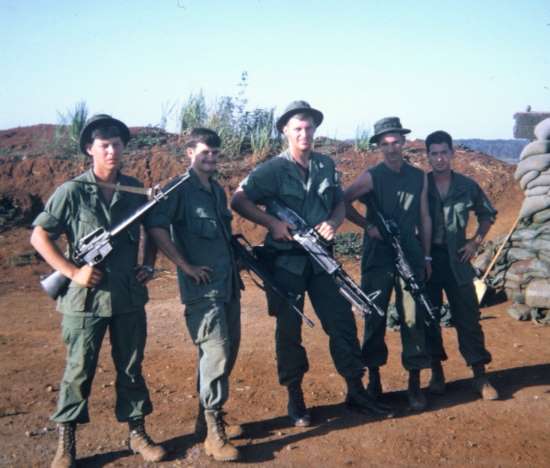 From 5 May until 12 May, the "Redcatchers" 12th Infantry Regiment worked in their new area of operations, seeking the locations of the enemy, again encountering light enemy resistance. Then they went into Cambodia from 12 May until 25 June 1970. SGT Arlie Spencer was killed in action during the 12th's time in Cambodia. The full story of events taking place from May 5th to May 19th for the 12th Infantry can be read on the Groups and Battles page, specifically under 199th LIB, 5th Battalion, 12th Infantry, Cambodia (May 5-19 1970) On the morning of May 15, 1970, while a Command and Control Helicopter from Charlie Company, 229th Assault Helicopter Battalion (AHB) was on the ground at YU 067398 to drop off reporters, it was attacked by 8 NVA with rifles and B-40 rockets. The aircraft went up in flames as troops from the 5-12th Infantry Regiment had been in contact to secure the area. Casualties were 1 US KIA and 3 US WIA. Arlie Spencer was part of the infantry defense of the small landing zone when the helicopter was shot out of the air. The men of Bravo Company walked into an ambush late in the afternoon in what they thought was an abandoned enemy base camp. SGT Pete Spencer lost his life during this event, and several were wounded in the firefight which lasted most of the night. No 'official' unit information on the encounter was documented in the Cambodia report by the 1st Cavalry Division, nor in the documents of the 12th Infantry Regiment. The story was told by the men who lived it and can be found in detail in the book "Raiding the Sanctuary". Exerpts from the book used with permission of the author [Read Ch 2 of manuscript here]. As it pertains to SGT Spencer, it shows by 1400 hours, Bravo Company, with the daily monsoon rains soaking the already exhausted Redcatchers to the bone, had moved out of the contact area, once again jungle pounding through the extremely thick Cambodian countryside. The company was paralleling the same river where the chopper had gone down, two hundred meters or so northeast of FSB Brown. When the 2nd and 3rd Platoons finished crossing over [rope bridge into enemy base camp], CPT Lee formed the company into a defensive perimeter. From the outset, it was apparent that the basecamp was huge and much too large for one regular line infantry company to handle. Allen Thomas of the 2nd Platoon states that, "This NVA compound was huge. After we formed a perimeter, each platoon started taking out short reconnaissance patrols to find out just what the extent of the camp was and see if there were any NVA around..." The patrol from the 3rd Platoon, which went in the opposite direction of Thomas's, was led by Terry Braun and Arlie "Pete" Spencer. Braun remembers, "CPT Lee summoned Pete Spencer and me to meet with him. He told us to take a few men and run a short recon patrol about 75 to 100 meters outside of the perimeter we had just set up. He suggested that we stay off any trails and then report back to him when we had gone a sufficient distance. We took along our RTO's, three M60 machine gun teams and a pointman. We tried to stay off the trails, but the thick bamboo bordering the camp kept forcing us back onto the well-beaten paths. When we had gone approximately 75 meters, we came upon a gully that ran next to the river we were paralleling. I stopped and told Pete, 'That's it. 75 meters. Let's go back.' Pete quickly shot back, 'The Captain said 75 to 100 meters.' He then pointed out fresh sandal tracks. You could actually see where the NVA wearing them had hurriedly slid down the embankment into the gully and back up the other side. The gully wasn't that large of a physical feature. It was probably an 8 to 12 foot drop down a very slippery and muddy trail. It ran about 50 to 80 feet to where the trail went back up a hill to the other side and it was probably a little less than that to the hill that surrounded the gully to our right. The river was to our left." Braun immediately called up CPT Lee and told him the situation and about the tracks. Loaning SGT Spencer his M60 team consisting of Ken Burmeister and Vaughn Bartley, he then told CPT Lee that Spencer was going to probe a little further. Braun continues. "Walter Case, who just hours ago had helped to rescue the burning crew of the Huey that was shot down, was pleading with the patrol to not enter the gully. He somehow knew that it was a bad omen. I was the seventh one to descend the hill and enter into it. My RTO would have been the eighth and final one, but as I was going down the hill, Pete Spencer was slipping and sliding in the mud trying to get up to the top on the other side. While watching him, I took a quick glance at the area around me. I immediately noticed an enemy bunker pointing in our direction from across the river. I put my hand up to stop the squad from going any further and halted my RTO, who was himself halfway down the trail leading into the gulley. Just at that moment, at approximately 1650 hours, there were two ear-splitting bursts of automatic weapons fire. There is a distinct difference in sound between and M16 rifle and an AK-47. The AK is much louder and makes more of a cracking noise when fired. The M16 looks like a toy and it has a milder popping sound. These bursts of fire were from an M16 and my first thought was that Pete Spencer had crawled up the other side, seen some enemy soldiers and fired at them. ..." Spencer had made it up to the opposite side of the gully when the firing began. However, it was not from his weapon or from anyone else's in the patrol. An NVA soldier, using an M16, had shot Spencer through the back of the head when he had appeared at the top of the gulley. He never knew what hit him. Seconds before the shots were fired, Spencer turned around to help Ron Scarbrough, who was carrying another M60 machine gun. The rounds that killed Spencer also hit Scarbrough, seriously wounding him in the back and buttocks. After the two bursts of fire, there was total silence in the gulley for several heart-pounding minutes. The men at the bottom of the ditch were sure that the enemy were fleeing as they had done many times prior to artillery fire crashing after them. That was not the case on May 15th. Within minutes, the 1st and 2nd Platoons at the company perimeter, 100 yards or so back from the 3rd Platoon, began receiving heavy and accurate AK-47, RPD and RPG fire at a distance of less than 75 meters. At least nine grunts were wounded in the opening fusillade. Bravo Company was strung out and under heavy enemy fire. There was nothing for the men to do but pray and spray the jungle in front of them with their weapons on full-automatic. Serpent A1, the O-1 observation plane buzzing over the contact was immediately driven off by a string of accurate ground to air machine gun fire. " The battle continued for hours more with the Company finally consolidating their platoons but they spent the night repelling probes by the NVA who were trying to find a weak spot. The firing would suddenly start up again, reach a crescendo after a few minutes and then die back down. The next morning, an overland attempt by Bravo Company of the 1st Cav's, 2nd Battalion, 12th Infantry was made earlier that morning to reach the survivors of Bravo Company at the basecamp. After two hours of hacking and tromping through the bush, they were themselves ambushed a couple of kilometers from FSB Brown and suffered one KIA and seven WIA right from the start. Bravo 2-12 immediately pulled back. It was the Sheridan's and ACAV's from I Troop, 3rd Squadron, 11th Armored Cavalry who finally got them out of the bunker complex where they continued to fight all day until 1630 hours. Several of the men from 3rd Platoon, including the platoon leader, raced back into the gully to retrieve the body of Pete Spencer. They made it back just as the column was leaving the area. But the column was ambushed about 1 klick from FSB Brown and another 8 men were wounded in action before they finally reached the relative safety of FSB Brown. SGT Arlie 'Pete' Spencer was posthumously awarded the Silver Star for his heroic actions of May 15, 1970. The Virtual Wall is working with the family to obtain the Silver Star Citation. The names of the men from 5th Battalion, 12th Infantry who were killed in action in Cambodia can be found here: 199th LIB, 5th Battalion, 12th Infantry, Cambodia (May 5-19 1970) Visit the following links to read more on the 5th Battalion, 12th Infantry, in Cambodia Visit a 'Redcatchers' website for more details 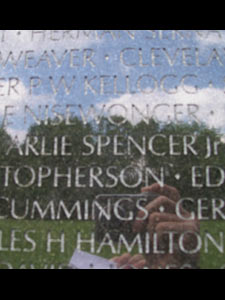 Photo of SGT Arlie 'Pete' Spencer's
name on the Wall in Washington D.C. It may have taken four decades, but a Campbell County native who died in the Vietnam War was permanently remembered in his hometown. Arlie Spencer, better known by his nickname "Pete," passed away nearly three years after his high school graduation in Jellico, Tennessee. The Jellico High School class of 1967 helped permanently remember the man described as "fun-loving" and "happy-go-lucky. "Because we never really knew what happened to him, and that started the ball rolling... seeking anyone in Jellico that remembered Pete, and they just hit on it," said Sgt. Spencer's sister, Sheila. At the Jellico Cemetery, a flagpole and stone memorial was introduced to Spencer's classmates. More than 20 of them, from across the country, were in the small town for the dedication at a local park. Below is a photograph of the flag pole and memorial stone. Read comments on the Jellcio High School Allumni Association efforts in putting up this memorial Read page 6 of 16 of Jellico HS Alum Association comments here: 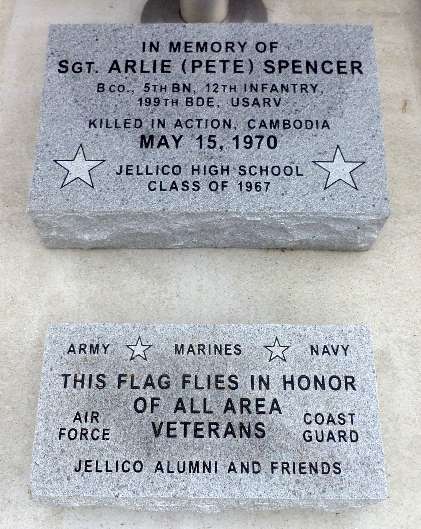 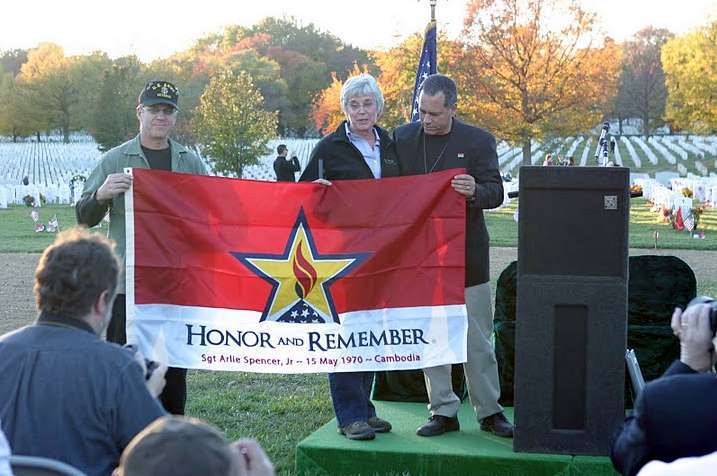
June 8, 2010 - Presentation of flag to Susan Spencer Booth in Lisbon Maryland in Memory of Pete
Below is a letter of thanks from SGT Spencer's wife Susan to the men of the 12th Infantry who served with Pete until the day he was killed. They were still the "good guys" she wrote recently. 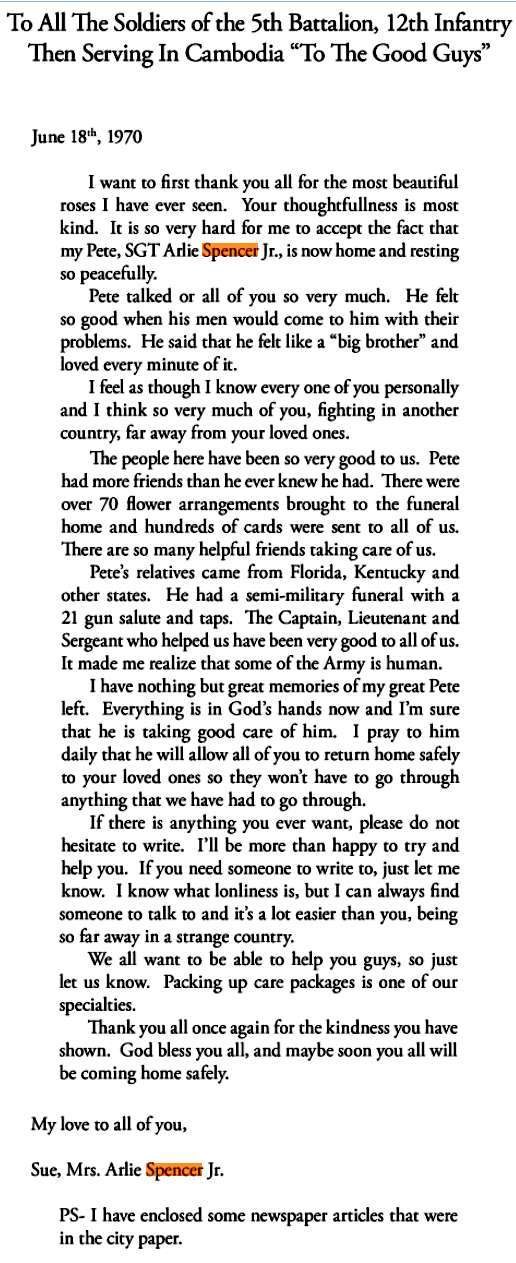
From Terry Braun's email of July 1, 2013. "The helicopter exploded (was shot down) the morning of May 15th. It brought a camera crew from CBS in to film our unit. Pete was killed in the afternoon of May 15th, at least 6 hours after the helicopter was shot down." "I was in the entire 26 hour firefight on May 15th to May 16th in the NVA Bunker Complex and we never saw a helicopter explode (except that morning). We had a soldier dropped from a Medevac as we were dusting him off (Vaughn Bartley, Pontiac, Michigan) but he survived and went to Fort Knox then Valley Forge for the next 56 weeks for multiple surgeries. My machine gunner, Ken Burmeister and I went to visit him at Christmas, the following year." "As far as the chopper that was shot down the morning of May 15, 1970, I can personally confirm 2 KIAs and 2 severely wounded (burned all over their bodies) that we dusted off but I was later told those 2 also died. The CBS crew left on that chopper and missed the May 15th -16th firefight." "I have included my versions of May 12-13 and May 15-16 to help clarify those events (Read them here). "Again, thank you so much for doing this for all the soldiers and families, it is greatly appreciated. I think of Arlie "Pete" Spencer everyday." - - - Terry Braun From Robert Gouge June 24, 2013 email: "I am glad that the information will be helpful. Once again, please use anything and everything at your leisure." "I have also attached the full manuscript to "Raiding the Sanctuary" for you to use as well [Read Chapter 2 of his manuscript here]. There is quite a bit of information in there that you may be able to use for other personnel and incidents during the Cambodian Incursion." "Please contact me at any time if you have any further questions or concerns. I'd be happy to help out in any way." - - - Robby Gouge -- The Virtual Wall, May 23, 2014 |
| Contact Us | © Copyright 1997-2019 www.VirtualWall.org, Ltd ®(TM) | Last update 08/15/2019 |